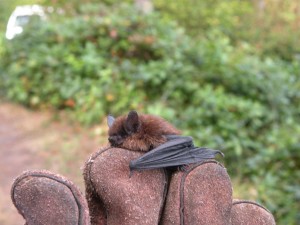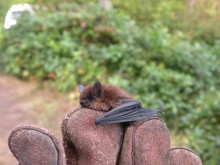— from Russel Barsh —
 The best available scientific evidence is in, and it’s a fact: San Juan County is very batty, and Orcas is the battiest island!
The best available scientific evidence is in, and it’s a fact: San Juan County is very batty, and Orcas is the battiest island!
Kwiaht director Russel Barsh has announced results of the first systematic survey of the county’s bats in 75 years.
The study included 105 nights of ultrasound recordings, visits to homes and barns where bats were reported roosting, and visual observations including dead or injured bats received by Wolf Hollow Wildlife Rehabilitation Center. “Over ten thousand bats were heard,” Barsh says, “and that is only perhaps one percent of what’s out there.” The most bat flyovers per hour were heard above lakes and ponds on Orcas.
Nine species of bats were identified by acoustic analyses; a tenth species (Keen’s Myotis) is probably also present but must be confirmed genetically. “This is a significant portion of the 15 species of bats that are known from Washington State as a whole,” says Barsh. All nine confirmed species were observed on Lopez, Orcas, and San Juan Islands, but in different proportions, which Barsh attributes to differences in the kinds of habitats that are available on each island. “For example,” Barsh says, “Yuma Myotis, which like to hunt over open water, were more abundant on Lopez, while California Myotis, which seem to prefer to hunt wooded areas, were more abundant on Orcas.”
Results of the 2014 study are consistent with an acoustic survey of Lopez in July 2013 conducted by Western Bat Working Group co-chair Ella Rowan with assistance by Barsh and Kwiaht. That study has already been submitted for publication.
The Kwiaht study also confirmed that San Juan County is an important reservoir of Townsend’s Big-Eared Bat, a federal and state species of concern found at only about a dozen maternity roosts in Washington. Townsends were identified on four islands. The reason for their relative abundance in San Juan County remains unclear, but farmers and gardeners should rejoice: this relatively large, sociable bat specializes in eating moths, in particular the moths that are most destructive of orchard trees. “Older, untended orchards must be a feast for them,” Barsh says.
The Kwiaht study also confirmed that many species of bats remain in the islands over the winter, dispersing locally rather than migrating to the mainland or hibernating. “Next year’s focus will be the dispersal pattern of winter bats,” Barsh says, “and what it is they are eating.” He is particularly interested in a tribe of moths that tend to emerge in January and February in the islands’ woodlands.
Data summaries and graphs will be posted on the Kwiaht website and Facebook page in the next few weeks.
The American Wildlife Conservation Foundation helped fund the Kwiaht study. Barsh also expressed appreciation for the professional support and encouragement of Ella Rowan, Greg Falxa, and Nancy Williams, and the generosity of homeowners that allowed him to record on their property.
For further information contact: Russel Barsh via email.
**If you are reading theOrcasonian for free, thank your fellow islanders. If you would like to support theOrcasonian CLICK HERE to set your modestly-priced, voluntary subscription. Otherwise, no worries; we’re happy to share with you.**









What wonderful news!! Particularly considering how many bats are dying from a disease! Keep up this terrific work!!
Very cool! I wonder what kinds of bats we see near our house on Orcas when we go out bat-watching in the woods around dusk. Maybe more than one species.
I am lifting and replacing the metal roof vents on my house; found approximately 20 bats so far. No idea what species.
Great work Russell.
Do they like commercially produced bat houses? We’re trying to discourage them from living in our house!
Most commercially produced bat houses don’t seem to work in our climate.
I really appreciated Russell’s assistance in analyzing my bat infestation this summer. I visually counted 140 bats exiting from my roof this summer and Russell’s ultrasonic equipment confirmed that, as well as identifying the species. Now that all the bats have left for the season, I will be doing some bat exclusion home repairs, but I love having the bats around, so will be working with Russell and Kwiaht to install a bat house that will replace my roof/house as a colony roost. I have loved and appreciated bats since my spelunking days as a teenager. I hope to encourage their continued homesteading on my property by installing one of Kwiaht’s designed bat houses, as the bats are excellent mosquito and other annoying insect deterrents, I just don’t want them in my roof.
Great work, Russel!
For those with unwanted bats in your buildings but a love for keeping them around I have studied this subject with the help of Russel and can help you exclude them without harming them. I can build and install custom bat houses according to plans provided by Kwiaht. I’d invite Russel out to your place for a consultation and so he can study more data points first. Email me if interested: xmichael.greenbergx@gmail.com